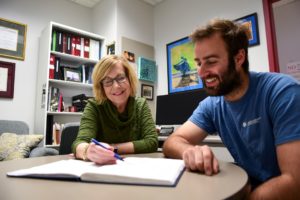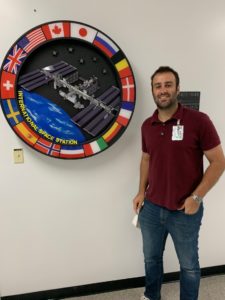- La Feria Community Holds Succesful Business Mixer Event
- Little Nashville to Take Place in Downtown Mercedes
- Lions Basketball Captures District Gold
- La Feria ISD Students Compete in Regional Chess Tournament
- Lions End First Half of 32-4A on a High Note
- La Feria ISD Held Another Successful Parent Conference
- Strong Appearance for Lions at Hidalgo Power Meet
- LFECHS Students Get to Meet Local Actress
- Students Participate in Marine Biology Camp
- Two LFECHS Students Qualify for All-State Band
Exploring The Impact Of Space Radiation On Plants
- Updated: December 30, 2022

Texas A&M-led, NASA-funded study investigates plant survival on long space missions
Written by Adam Russell
The future of space exploration depends on plants.
Rockets and other exploratory technology can take astronauts to the moon and beyond, but plants will sustain their trips over longer periods. As NASA explores the potential for longer space flights, continued stays on the International Space Station or even the future colonization of the moon or planets like Mars, their scientists know that plants are needed for survival.
From food and water purification to carbon dioxide removal and oxygen production, plants are the foundation of humanity’s life on Earth and beyond.
However, exposure to extreme environmental factors related to space travel, including microgravity and space radiation, impacts biological systems like plants.
Researchers in the Department of Biochemistry and Biophysics at the Texas A&M College of Agriculture and Life Sciences are striving to understand the largely unknown effects of these extreme conditions in space.
The impact of radiation on plant telomeres
Dorothy Shippen, Ph.D., University Distinguished Professor and Regents Professor in the Department of Biochemistry and Biophysics, is leading a study to determine how radiation exposure in space impacts plant telomeres, which are basic building blocks in the DNA at the very ends of chromosomes. Much like plastic tips on shoelaces prevent the lace from fraying, telomeres help keep chromosomes stable and healthy.
Telomeres are not static, Shippen said. They contract and expand due to environmental stressors, and if they get outside the normal size range, they lose their protective function. There is evidence in plants and humans that chromosomes become unstable when telomeres get too short, and various cancers in humans are associated with telomeres lengthening.
NASA is interested in learning how and why some of the extreme stressors in space, particularly space radiation like gamma and cosmic rays, impact plants. This is where the Shippen Lab at Texas A&M saw an opportunity to contribute.
“Plants are obviously very important for space travel, and so from a practical point of view we want to understand how we can help them survive the extreme conditions of space,” Shippen said. “There is so much we don’t know, but this telomere research will answer some of the basic questions we have related to plants and space radiation.”

The team and the study
Shippen is known internationally for her pioneering work in establishing the plant Arabidopsis thaliana as a model for telomere biology. She will act as principal investigator and team with collaborators Sarah Wyatt, Ph.D., at Ohio University and Susan Bailey, Ph.D., at Colorado State University.
Wyatt is an international leader in plant molecular biology who has been involved in several spaceflight experiments with Arabidopsis. Bailey is a renowned radiation biologist who first reported changes in telomere length dynamics associated with a long-duration mission by astronaut Scott Kelly during the NASA Twins Study.
Borja Barbero Barcenilla, a postdoctoral fellow in the Shippen Lab, will conduct experiments and collect data for the study.
The team’s specific goals are to assess the impact of space radiation on oxidation status, telomere length dynamics and genome stability in plants.
“There is interest in telomeres because they are linked to survivability, and it turns out the environment can influence the size of telomeric DNA tract,” Shippen said. “The telomeres are like a reporter for the physiological health of organisms and a biomarker for their ability to be healthy. We are interested in understanding how plants respond to the stress of space radiation and then figure out how to protect them.”
Space radiation’s impact on plants
The research team hypothesizes that exposure to space radiation triggers genome oxidation and an increase in the activity of telomerase, a specialized enzyme responsible for maintaining telomeric DNA. The preliminary data suggests a strong connection between them.
The preliminary data of Shippen and Wyatt was gathered from Arabidopsis seedlings sent into low Earth orbit on a previous space flight. The team showed that the telomere lengths of the plants did not change, but that telomerase activity increased significantly – at least 150-fold. This unexpected finding suggests the telomerase enzyme may play some protective role during space travel.
The NASA-funded research will allow Shippen’s team to send their own plants into space in the future and perform radiation experiments in laboratories that will mimic the environment plants might be exposed to in space.
Land plants may, in fact, be very well equipped to go to space because they are remarkably tolerant to a broad range of environmental stresses on Earth like drought, disease and pests, she said. The researchers are interested to see how space radiation impacts plants directly from seed to flower. In addition, the team will collect seeds and test the progeny to see how radiation affects plants across generations. Chronic exposure to space radiation is expected to pepper the plant genome with mutations.
Our need to learn more
Scientists have learned many things about how plants react to microgravity environments through experiments designed by the Wyatt lab for flights to the International Space Station.
But little is known about how plants react to space radiation, Barcenilla said. He expects Arabidopsis plants involved in the project will be aboard a flight to the International Space Station sometime in 2024.
“This is all very new, and we need to understand how this exposure to radiation plays out,” Barcenilla said. “Right now, the level of radiation these samples were exposed to in our preliminary experiments in low Earth orbit aboard the International Space Station are much less than what they will suffer on the moon or Mars. The radiation exposure will exponentially increase on those missions, so we need to understand how plants will react to the much higher levels of radiation.”
An important first step
Barcenilla said the study is an important step forward for space travel but could also help scientists better understand how plants react and adapt to stressors here on Earth.
Intentionally exposing plants to radiation has led to beneficial mutations for plant breeding purposes, with the goal of generating plant varieties better suited to contend with a variety of stressors, he said.
“In the end, we are trying to develop better, smarter ways to help plants withstand stressors,” he said. “It just happens that we are studying stressors that are very, very harsh on plant DNA. So, the mutations that benefit us in space can also benefit us here on Earth.”
Shippen said it is exciting the project has classical agriculture and engineering components focused on revealing basic science for an innovative field like interstellar travel. But the research may also advance scientific understanding about how space travel can impact other biological systems, including humans, and offer insights into adaptations.
“I think we are in a really good position to deliver some interesting data,” she said. “We have the right collaborators, and we feel privileged that NASA sees the value in these experiments and trusts us with them.”





